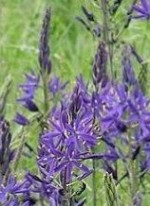 Also called Indian hyacinth, wild hyacinth, camash, and camas, this perennial bulb is a member of the asparagus family, Asparagaceae, that also includes lily of the valley, agave, and hosta. It is native to the Pacific Northwest where it grows in moist mountain meadows. Plants form a clump 2′ across and 3-4′ tall of strap-shaped leaves up to 2′ long. In late spring terminal racemes of 20-80 star-shaped flowers appear above the foliage, opening sequentially from the bottom. Each flower has 6 petal-like tepals and varies in color from white or pale lilac to deep purple or blue-violet. Quamash is a good choice for a rain garden, meadow planting or wild flower garden. It looks best when planted in groups of 10-15 bulbs with other plants that hide its foliage as it goes into summer dormancy. The genus name, Camassia, comes from the Nootka Chinook Indian word kamas, a variant of Quamash. The specific epithet, leichtlinii, honors Max Leichtlin (1831-1910), of Baden-Baden, Germany, who introduced many plants into cultivation, notably from the Near East.
Also called Indian hyacinth, wild hyacinth, camash, and camas, this perennial bulb is a member of the asparagus family, Asparagaceae, that also includes lily of the valley, agave, and hosta. It is native to the Pacific Northwest where it grows in moist mountain meadows. Plants form a clump 2′ across and 3-4′ tall of strap-shaped leaves up to 2′ long. In late spring terminal racemes of 20-80 star-shaped flowers appear above the foliage, opening sequentially from the bottom. Each flower has 6 petal-like tepals and varies in color from white or pale lilac to deep purple or blue-violet. Quamash is a good choice for a rain garden, meadow planting or wild flower garden. It looks best when planted in groups of 10-15 bulbs with other plants that hide its foliage as it goes into summer dormancy. The genus name, Camassia, comes from the Nootka Chinook Indian word kamas, a variant of Quamash. The specific epithet, leichtlinii, honors Max Leichtlin (1831-1910), of Baden-Baden, Germany, who introduced many plants into cultivation, notably from the Near East.
Type: Perennial bulb
Bloom:Terminal racemes of white, pale lilac, deep purple or blue-violet flowers in late spring
Size: 3-4′ H x 1-2′ W
Light: Full sun to part shade
Soil: Fertile, moist, acidic; tolerates some drought after bloom time
Hardiness: Zones 5-9
Care: Low maintenance
Pests and Diseases: None of significance
Propagation: Separation of offsets, seed
Companion Plants:Bleeding heart, Bowle’s golden sedge, marsh spurge